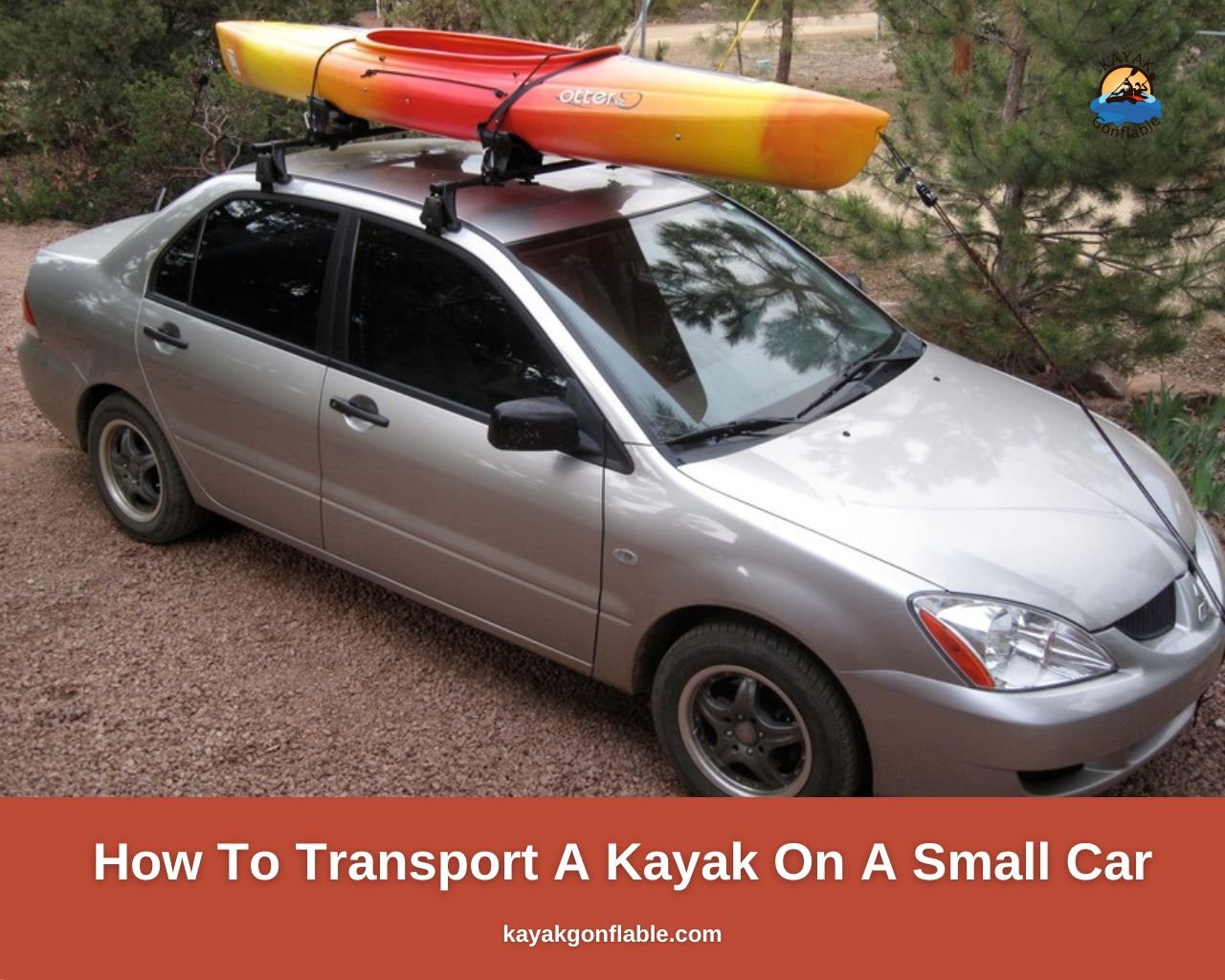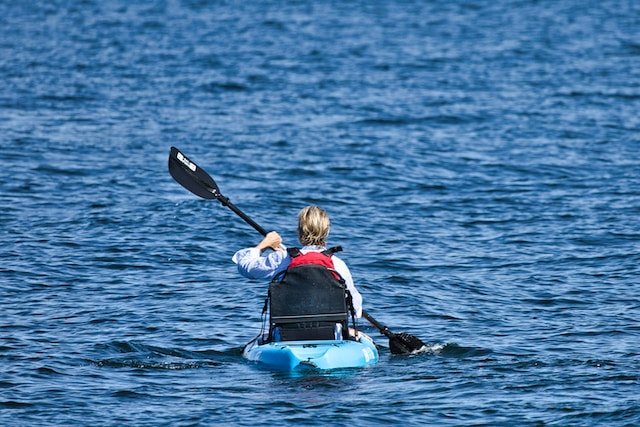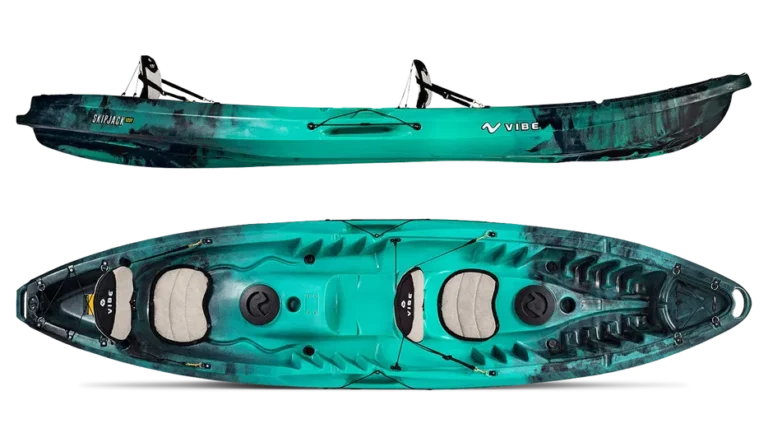So transportieren Sie ein Kajak in einem Kleinwagen

Kajakfahren macht Spaß, und wenn Sie erst einmal süchtig sind, müssen Sie nur noch den Weg zurück zum Wasser finden, um eine weitere tolle Zeit zu verbringen. Daher ist es keine Überraschung, dass sich die meisten Kajakfahrer früher oder später ein eigenes Kajak zulegen.
Ein Kajak zu besitzen ist großartig; Das bedeutet, dass Sie jederzeit aufs Wasser gehen und nach Herzenslust paddeln können. Allerdings gibt es einen Haken.
Sie können kein Kajak fahren, wenn Ihr Kajak nicht im Wasser ist, und wenn Sie nicht in der Nähe eines Gewässers wohnen, müssen Sie einen Weg finden, Ihr Kajak zu bewegen, um die Freude am Paddeln zu haben.
Mehrere Möglichkeiten Transport eines Kajaks existieren, aber wenn Sie hier sind, haben Sie höchstwahrscheinlich ein kleines Auto und fragen sich, ob es möglich sein wird, damit Ihr Kajak sicher von einem Ort zum anderen zu transportieren.
Die Antwort ist ja. Es ist tatsächlich möglich, Kajaks mit Kleinwagen sicher zu transportieren. Das nächste Dilemma besteht darin, diese Aufgabe zu bewältigen, aber keine Angst!
Dieser Artikel hilft Ihnen weiter und enthält alle notwendigen Informationen, die Sie zum sicheren Transport Ihres Kajaks benötigen. Tauchen Sie ein und genießen Sie es.
Wie stellen Sie fest, ob Ihr Kajak zu groß für Ihr Auto ist?
Auch wenn der Transport eines Kajaks in einem Kleinwagen möglich ist, müssen Sie zunächst prüfen, ob Ihr Kajak und Ihr Fahrzeug kompatibel sind.
Wenn sie nicht kompatibel sind, ist der Transport des Kajaks mit diesem Auto möglicherweise immer noch möglich, aber das wäre sehr unsicher und könnte die Sicherheit Ihres Kajaks und anderer Personen auf der Straße gefährden.
Wenn Sie Ihr Kajak auf unsichere Weise transportieren, könnte dies auch zu Problemen mit den Strafverfolgungsbehörden führen. Daher kann die Prüfung, ob Ihr Kajak zu groß für Ihr Auto ist, nicht überbewertet werden.
Um festzustellen, ob Ihr Kajak zu groß für Ihr Fahrzeug ist, gibt es drei Möglichkeiten, die im Folgenden erläutert werden.
1. Überprüfen Sie die Länge des Kajaks
Das erste und offensichtlichste Problem beim Transport Ihres Kajaks in Ihrem Kleinwagen ist, dass das Kajak länger ist als das Auto. Normalerweise können auch lange Kajaks auf den Dächern von Kleinwagen transportiert werden, unabhängig davon, ob Sie einen verwenden Kajakständer oder nicht.
Auch die Länge des Kajaks stellt kein Hindernis dar, wenn Sie sich für die Verwendung eines Kajakanhängers entscheiden. Wenn Sie das Kajak jedoch transportieren möchten, indem Sie es in Ihr Auto stecken, ist die Länge sehr wichtig.
Wenn nach dem Beladen mehr als die Hälfte des Kajaks heraushängt, transportieren Sie es nicht auf diese Weise. Der Grund dafür ist, dass, wenn mehr als die Hälfte des Kajaks aus dem Fahrzeug hängt, der größte Teil des Kajakgewichts nicht abgestützt wird, was zu unsicheren Transportbedingungen führen würde.
Es ist außerdem eine gute Idee, sich über alle Gesetze in Ihrem Bundesstaat, entlang Ihrer Reiseroute und an Ihrem Zielort zum Transport von Kajaks zu informieren, um zu vermeiden, dass Ihre Reise durch die Strafverfolgungsbehörden unterbrochen wird.
Diese Gesetze, wie zum Beispiel das in den meisten Bundesstaaten, das das Anbringen einer leuchtenden Flagge an allem vorschreibt, was über das Heck Ihres Fahrzeugs oder Anhängers hinausragt, dienen dazu, die Sicherheit im Straßenverkehr zu gewährleisten.
Berücksichtigen Sie diese daher immer, bevor Sie eine Transportmethode für Ihr Kajak auswählen, und stellen Sie sicher, dass Sie sie befolgen.
2. Überprüfen Sie das Gewicht des Kajaks
Das nächste Problem hat mit dem Gewicht des Kajaks zu tun. Wenn Sie es wünschen Transport Ihres Kajaks auf dem Dach An Ihrem Fahrzeug, mit oder ohne Dachträger, müssen Sie zunächst sicherstellen, dass das Dach Ihres Autos das Gewicht des Kajaks tragen kann, insbesondere wenn Sie ein schweres Kajak besitzen.
Dieser Teil der Gleichung ist oft einfach, da die meisten Kajaks nicht allzu schwer sind, aber wenn Sie eines besitzen AngelkajakErkundigen Sie sich unbedingt beim Hersteller Ihres Autos, ob das Dach des Autos das Gewicht tragen kann. Wenn Sie dies nicht tun, könnte Ihr Auto und Kajak beschädigt werden.
Die Überprüfung des Gewichts des Kajaks ist ebenfalls wichtig, denn wenn Sie es auf dem Dach transportieren, müssen Sie das Boot über Ihren Kopf heben können, um es auf das Autodach zu laden, und wenn es zu schwer ist, könnten Sie sich verletzen und verletzen Möglicherweise beschädigen Sie dabei Ihr Kajak.
Das Gewicht des Kajaks wirkt sich auch auf das Entladen des Kajaks aus. Berücksichtigen Sie es daher unbedingt bei der Wahl Ihrer Transportmethode.
3. Überprüfen Sie die Anhängelast Ihres Autos
Diese Anforderung ist ein Muss für diejenigen, die ihr Kajak lieber im Schlepptau transportieren möchten Kajakanhänger und sollte nicht auf die leichte Schulter genommen werden.
Wenn Sie darauf bestehen, mit Ihrem Kleinwagen einen Kajakanhänger zu ziehen, und die dafür erforderliche Kraft nicht innerhalb der Zugkapazität des Wagens liegt, belasten Sie den Motor und die Karosserieteile des Wagens zu sehr.
Das ist das perfekte Rezept für den vorzeitigen Untergang eines jeden Fahrzeugs. Es besteht auch die Gefahr, dass das Fahrzeug auf Sie stößt und dadurch möglicherweise Ihr Kajak beschädigt wird.
So transportieren Sie ein Kajak in einem Kleinwagen
Der Transport eines Kajaks in einem Kleinwagen ist möglich und kann auf vier Arten erfolgen, nämlich:
- Befestigen Sie das Kajak mithilfe eines Kajakträgers auf dem Autodach.
- Befestigen Sie das Kajak ohne Verwendung eines Kajakträgers auf dem Autodach.
- Das Kajak mit einem Kajakanhänger schleppen.
- Stecken Sie das Kajak in Ihr Auto.
Jede dieser Methoden hat ihre Vor- und Nachteile und sollte vor der Implementierung sorgfältig abgewogen werden.
Denn wenn das Kajak während des Transports vom Fahrzeug fällt, könnte es beschädigt werden oder, schlimmer noch, einen Unfall verursachen. Im Folgenden wird jede Methode im Detail erläutert, um Sie auf den Transport des Kajaks vorzubereiten.
Befestigen Sie das Kajak mithilfe eines Kajakträgers auf dem Autodach
Dies ist die am meisten empfohlene und sicherste Art, Ihr Kajak von einem Ort zum anderen zu transportieren. Um diese Methode zu implementieren, benötigen Sie zunächst eine Kajak-Dachträger.
Ein Kajak-Dachträger ist ein Gerät, das auf dem Dach eines Autos befestigt wird und dazu dient ein Kajak transportieren. Da sind viele verschiedene Arten von Kajaks Dachträger, und jeder hat seine eigenen Vor- und Nachteile.
Einige Kajak-Dachträger sind so konzipiert, dass sie nur ein Kajak aufnehmen können, während andere mehrere Kajaks aufnehmen können. Einige sind einfach zu installieren, während andere einen hohen Montageaufwand erfordern.
Ein großer Vorteil von Dachträgern besteht darin, dass sie einen stabilen Rahmen bieten, an dem Sie Ihr Kajak befestigen können, sodass es nicht direkt auf dem Dach des Autos aufliegt und dieses möglicherweise beschädigt.
Bevor Sie den Träger erwerben, ist es wichtig, ihn sowohl mit Ihrem Kajak als auch mit Ihrem Auto abzugleichen, um sicherzustellen, dass sie perfekt zusammenpassen.
Damit Ihr Auto für einen Dachträger geeignet ist, müssen in den meisten Fällen bereits Querträger vorhanden sein. Wenn Ihr Auto also keine Querträger hat, ist diese Methode möglicherweise nicht das Richtige für Sie.
Nach dem Kauf und der Installation des Kajakträgers (Sie können dies selbst tun oder jemanden beauftragen, der über das entsprechende Know-how oder Werkzeug verfügt), benötigen Sie Gurte oder Bungee-Seile und eine Plane. Dann kann es losgehen.
Verfahren
- Besorgen Sie sich das gesamte notwendige Zubehör (Gestell, Gurte oder Bungee-Seile und eine Plane).
- Installiere das Kajakständer.
- Heben Sie das Kajak auf den Dachträger. Sie können dies selbst bewerkstelligen, wenn Sie sicher sind, dass Sie das Kajak problemlos über Ihren Kopf heben können. Wenn dies nicht möglich ist, können Sie jederzeit einen Freund oder Nachbarn um Hilfe bitten. Stellen Sie sicher, dass das Kajak gut auf dem Dachträger positioniert ist. Die Position hängt davon ab, ob das Kajak mit der rechten Seite nach oben, auf der Seite oder kopfüber auf den Kajakträger geladen werden soll. Eine falsche Positionierung könnte zu einer Beschädigung des Kajaks führen.
- Zentrieren Sie das Kajak auf dem Dachträger. Das Zentrieren des Kajaks ist wichtig, da ein gut zentriertes Kajak einfacher zu sichern ist und weniger wahrscheinlich herunterfällt.
- Als nächstes sichern Sie das Kajak entweder mit Gurten, Bungee-Seilen oder beidem. Stellen Sie sicher, dass das Kajak gut festgezogen ist, sodass es sich unter keinen Umständen bewegen kann, bis Sie zum Entladen bereit sind. Denken Sie daran, den Bug und das Heck ordnungsgemäß zu befestigen, aber ziehen Sie das Kajak nicht zu fest an, um Verformungen zu vermeiden.
- Nutzen Sie nun die Plane dazu Decken Sie Ihr Kajak ab um es vor den Elementen zu schützen.
- Überprüfen Sie Ihre Arbeit noch einmal und korrigieren Sie eventuelle Fehler.
- Sobald das Kajak sicher auf dem Autodach steht und Sie die gesamte benötigte Ausrüstung zusammengepackt haben, kann es losgehen. Stellen Sie sicher, dass Sie sicher fahren und alle Verkehrsregeln einhalten, um eine Unterbrechung Ihrer Fahrt zu vermeiden. Überprüfen Sie das Kajak regelmäßig, um sicherzustellen, dass es während der gesamten Fahrt immer noch sicher auf Ihrem Dach befestigt ist.
- Wenn Sie Ihr Ziel erreicht haben, ruhen Sie sich nach Bedarf aus, laden Sie dann Ihre Ausrüstung ab und machen Sie sich auf den Weg ins Wasser. Denken Sie daran, Spaß zu haben.
Befestigen des Kajaks am Autodach ohne Verwendung eines Kajakträgers.
Der nächste Weg Transport von Kajaks Bei Kleinwagen besteht die Möglichkeit, sie ohne Verwendung eines Dachträgers auf dem Dach Ihres Autos zu befestigen.
Diese Methode steht all jenen zur Verfügung, deren Autos nicht mit Querträgern für die einfache Montage eines Kajakträgers ausgestattet sind oder die kein Geld für einen Dachträger ausgeben möchten.
Die hier erforderlichen Schritte unterscheiden sich nicht wesentlich von denen bei der Verwendung eines Kajakträgers. Es ist jedoch ratsam, zunächst etwas als Polsterung oder Isolierung zwischen dem Dach Ihres Autos und Ihrem Kajak zu besorgen.
Dadurch wird sichergestellt, dass das Kajak nicht direkt auf dem Dachträger aufliegt, sodass keine Gefahr besteht, dass einer von beiden beschädigt wird, auch wenn es sich um geringfügige Schäden handelt, z. B. durch das Abkratzen des Lacks vom Dach Ihres Autos.
Verfahren
- Besorgen Sie sich das gesamte nötige Zubehör (das Material, das als Polsterung dient, Gurte oder Bungee-Seile und eine Plane).
- Bringen Sie die Polsterung auf dem Autodach an.
- Laden Sie das Kajak auf das Dach des Autos. Stellen Sie sicher, dass dies so sicher wie möglich geschieht, da Sie sich verletzen und/oder das Kajak beschädigen könnten, wenn Sie nicht vorsichtig sind, insbesondere wenn das Kajak herunterfällt, nachdem Sie es über Ihren Kopf gehoben haben.
- Zentrieren Sie das Kajak auf dem Autodach. Stellen Sie sicher, dass das Kajak gut positioniert und so ausbalanciert wie möglich auf dem Autodach ist. Dies hilft bei der Sicherung des Kajaks.
- Befestigen Sie das Kajak mit Gurten, Bungee-Seilen oder beidem am Dachträger. Es gibt verschiedene Methoden zur Sicherung des Kajaks, wenn kein Dachträger verwendet wird. Es liegt also an Ihnen, den Stil zu wählen, der am besten zu Ihnen passt. Wenn Sie Bungee-Seile oder andere starke Seile verwenden, achten Sie darauf, dass die Knoten gut festgebunden sind und sich nicht so leicht lösen lassen. Sie können jederzeit lernen, wie man stabile Knoten bindet, bevor Sie mit dieser Methode beginnen.
- Anschließend decken Sie das Kajak mit der Plane ab und schützen es vor Witterungseinflüssen.
- Überprüfen Sie Ihre Arbeit noch einmal und korrigieren Sie eventuelle Fehler.
- Wenn alles geklärt ist und Sie bereit sind, fahren Sie Ihr Auto so sicher wie möglich und halten Sie sich dabei an alle Verkehrsregeln und Vorschriften. Stellen Sie sicher, dass Sie Ihr Kajak während der Fahrt regelmäßig überprüfen, um sicherzustellen, dass es noch sicher auf dem Dach Ihres Autos befestigt ist.
- Sobald Sie Ihr Ziel erreicht haben, laden Sie Ihr Gepäck ab und beginnen Sie Ihr Abenteuer. Denken Sie daran, sicher zu sein und Spaß zu haben.
Abschleppen des Kajaks mit einem Kajakanhänger
Kajakfahren ist eine tolle Möglichkeit, draußen zu sein und das Wasser zu genießen, aber der Transport Ihres Kajaks kann mühsam sein. Dies gilt insbesondere dann, wenn Sie in einer ländlichen Gegend leben und eine gewisse Strecke zurücklegen müssen, um zum nächsten Gewässer zu gelangen.
Glücklicherweise kann ein Kajakanhänger den Transport Ihres Kajaks erheblich erleichtern. Ein Kajakanhänger ist ein kleiner Anhänger, der speziell für den Transport von Kajaks konzipiert ist.
Es verfügt über zwei kleine Räder und einen Rahmen, der das Kajak trägt. Der Anhänger wird an einem Fahrzeug befestigt und ermöglicht Ihnen den Transport Ihres Kajaks zum Wasser. Kajakanhänger sind in verschiedenen Größen erhältlich und bieten Platz für ein oder mehrere Kajaks.
Der wichtigste Faktor beim Kauf eines Kajakanhängers ist das Gewicht. Die Gewichtsangabe ist das maximale Gewicht, das der Anhänger sicher ziehen kann.
Es ist auch wichtig, die Größe der Kajaks zu berücksichtigen, die auf dem Anhänger transportiert werden, denn selbst wenn der Anhänger das Gewicht des Kajaks tragen kann, würde dies zu einer unsicheren Transportumgebung führen, wenn die Größe des Kajaks nicht zum Anhänger passt.
Ein wichtiger Faktor, den Sie vor dem Kauf eines Kajakanhängers berücksichtigen sollten, ist die Anhängelast Ihres Autos. Sobald Sie sicher sind, dass Ihr Auto den Anhänger sicher ziehen kann, wenn das Kajak oder die Kajaks beladen sind, können Sie den Anhänger kaufen.
Sie müssen sich außerdem ein Abschlepppaket besorgen, um das Kajak ordnungsgemäß abschleppen zu können. Bei dieser Methode müssen Sie Ihren Anhänger an der Anhängerkupplung des Autos an- und abkuppeln. Stellen Sie daher sicher, dass Sie dafür bereit sind, bevor Sie diese Route befahren.
Das Abschleppen Ihres Kajaks ist eine gute Möglichkeit, es zu transportieren, da es im Gegensatz zum Transport auf dem Autodach nicht mehr über den Kopf gehoben werden muss.
Das ist ein toller Bonus, denn es bedeutet zweierlei: Erstens ist die Wahrscheinlichkeit geringer, dass Sie sich verletzen oder Ihr Kajak beschädigen, während Sie es auf den Anhänger laden.
Denn bei den meisten Anhängern müssen Sie das Kajak nur etwa auf Hüfthöhe anheben, um es sicher auf den Kajakanhänger zu laden.
Ein weiterer großer Vorteil besteht darin, dass der Stress, Ihr Kajak beim Beladen auf den Dachträger ständig anheben oder vom Dach entladen zu müssen, entfällt. Das bedeutet, dass Sie Ihren Körper weniger belasten, und das ist immer gut so.
Doch wie alles hat auch diese Transportart ihre Nachteile, allen voran die drastische Reduzierung der Orte, an denen Sie Ihr Fahrzeug sicher verstauen können.
Dies liegt daran, dass Ihr Fahrzeug beim Ziehen des Anhängers praktisch doppelt so lang ist, sodass es schwieriger wird, einen geeigneten Parkplatz zu finden.
Das Ergebnis ist, dass Sie höchstwahrscheinlich in einiger Entfernung von der Stelle parken müssen, an der Sie Kajak fahren möchten, und das wird auch der Fall sein Tragen Sie das Kajak über eine längere Distanz.
Hinzu kommt, dass Sie den Kajakanhänger an- und abkoppeln müssen, wenn Sie das Auto für andere Besorgungen nutzen möchten, es sei denn, Sie möchten den Kleinwagen ausschließlich zum Ziehen des Kajakanhängers nutzen, was sehr nervig sein kann ermüdend.
Alles in allem ist das Ziehen des Kajaks mit einem Kajakanhänger jedoch eine großartige Möglichkeit, Ihr Kajak zu transportieren, und Sie sollten es unbedingt in Betracht ziehen, wenn Sie über die Mittel dafür verfügen.
Stecken Sie das Kajak in Ihr Auto
Die letzte Möglichkeit, ein Kajak zu transportieren, besteht darin, es einfach im Auto zu verstauen. Bei dieser Methode wird das Kajak so beladen, dass ein Teil aus dem Auto herausragt, und dann wird das Kajak so, wie es ist, mit Seilen und Gurten gesichert.
Es wird dringend davon abgeraten, das Kajak zum Transport im Auto zu verstauen, wenn mehr als die Hälfte des Kajaks nach dem Beladen aus dem Auto herausragt oder wenn das Kajak sehr schwer ist.
Die Methode eignet sich jedoch hervorragend für diejenigen mit kleinen Kajaks, die aus dem einen oder anderen Grund die anderen Methoden zum Transport eines Kajaks in einem Kleinwagen nicht anwenden können.
Diese Methode wird auch am wenigsten empfohlen, da sie zwar einfach, aber auch am unsichersten ist und diejenigen, die sie anwenden, oft schnell als Neulinge in der Welt des Kajakfahrens abgestempelt werden.
Wenn Sie diese Methode anwenden möchten, stellen Sie sicher, dass Sie die in Ihrer Region geltenden Transportvorschriften einhalten, und befestigen Sie sicherheitshalber eine bunte Flagge an dem Teil des Kajaks, der aus dem Fahrzeug herausragt Sie sind für andere Verkehrsteilnehmer gut erkennbar und vermeiden mögliche Unfälle.
Außerdem müssen Sie das Kajak regelmäßig überprüfen, um sicherzustellen, dass es noch sicher in Ihrem Auto ist, insbesondere wenn Sie mit dieser Transportmethode an die Grenzen des Kajaktransports gehen.
Planen Sie Ihre Reise
Unabhängig davon, für welche Art des Kajaktransports Sie sich entscheiden, ist die Planung Ihrer Reise eine gute Möglichkeit, um sicherzustellen, dass Ihre Reise so reibungslos wie möglich verläuft und die Wahrscheinlichkeit von Störungen oder Pannen möglichst gering ist. Hier ein paar Tipps, die Ihnen weiterhelfen:
- Planen Sie Ihre Route im Voraus. Dies wird Ihnen helfen herauszufinden, welche Straßen für Kajaks am besten geeignet sind.
- Vermeiden Sie Autobahnen und stark befahrene Straßen. Das Letzte, was Sie wollen, ist, mit Ihrem Kajak auf dem Dach Ihres Autos im Stau stecken zu bleiben.
- Sie können auch außerhalb der Hauptverkehrszeiten auf die Straße gehen, um dem Verkehr auszuweichen.
Obwohl es schwierig sein kann, Kajaks von Ort zu Ort zu transportieren, ist der Transport eines Kajaks in einem kleinen Auto mit ein wenig Einfallsreichtum und Mühe möglich. Es gibt vier verschiedene Möglichkeiten, ein Kajak in einem Kleinwagen zu transportieren.
Berücksichtigen Sie bei Ihrer Planung unbedingt die Größe Ihres Autos und die Größe Ihres Kajaks. Wenn Sie einen Dachträger haben, können Sie das Kajak mit Gurten auf dem Dach Ihres Autos befestigen und dann zu Ihrem Ziel fahren.
Sie können das Kajak auch auf einen laden Kajakwagen oder Anhänger zum Transport Ihres Kajaks.
Wenn Sie keinen Dachträger haben, können Sie das Kajak entweder auf dem Dach des Fahrzeugs befestigen, um es zu transportieren, oder das Kajak hinten in Ihrem Auto verstauen und es mit Bungee-Seilen an Ort und Stelle halten, dann kann es losgehen.
Für welche Variante Sie sich auch entscheiden, vergessen Sie nicht, eine Plane oder ähnliches Material zu verwenden, um Ihr Kajak vor Witterungseinflüssen zu schützen, insbesondere wenn Sie längere Zeit unterwegs sind. Befolgen Sie alle Transportregeln und -vorschriften und fahren Sie sicher an Ihr Ziel.
Anschließend können Sie Ihre Ausrüstung abladen, aufs Wasser gehen und so viel paddeln, wie Sie möchten. Wenden Sie sichere Kajakfahrpraktiken an und haben Sie Spaß auf dem Wasser!
Häufig gestellte Fragen
Passt ein Kajak in mein Auto?
Der beste Weg, diese Frage zu beantworten, besteht darin, die Abmessungen sowohl des Kajaks als auch Ihres Autos zu messen.
Viele Menschen gehen davon aus, dass ein Kajak in ihr Auto passt, aber das ist nicht immer der Fall. Wenn Sie ein kleines Auto haben, müssen Sie sich möglicherweise ein kleineres Kajak besorgen. Wenn Sie einen großen SUV haben, können Sie möglicherweise auch ein größeres Kajak hineinpassen.
Glücklicherweise gibt es, selbst wenn Sie ein kleines Auto haben, viele Möglichkeiten, das Kajak zu transportieren, ohne es in das Auto zu verstauen.
Welches ist das beste Auto für Kajaks?
Beim Transport von Kajaks sind nicht alle Autos gleich. Einige Fahrzeuge sind dafür besser geeignet Kajaks tragen als andere.
Daher gibt es keine allgemeingültige Antwort auf diese Frage, da jeden Tag neue Fahrzeuge hergestellt werden und diese besser auf die Bedürfnisse von Kajakfahrern zugeschnitten sind. Nachfolgend sind einige der besten Fahrzeuge für Kajakfahrer aufgeführt:
- Subaru Outback
- Nissan Rouge
- Ford F 150
- Jeep Grand Cherokee
- Dodge Ram
Kann ein Kajak auf ein Auto fahren?
Kann ein Kajak auf ein Auto fahren? Die Antwort ist ja! Sie können ein Kajak sicher auf Ihrem Auto transportieren. Hier sind einige Tipps, die Ihnen dabei helfen, dies sicher zu tun:
- Stellen Sie sicher, dass Ihr Auto in gutem Zustand ist und über einen Dachträger verfügt, der das Gewicht des Kajaks tragen kann.
- Binden das Kajak mit Seil oder Gurten sicher herunterlassen.
- Decken Sie das Kajak mit etwas ab (z. B. einer Plane), um es vor Witterungseinflüssen zu schützen.
- Fahren Sie sicher an Ihr Ziel.
Kann man ein Kajak ohne Dachträger auf ein Auto montieren?
Diese Frage stellen sich viele Kajakfahrer irgendwann. Wie sich herausstellt, lautet die Antwort ja.
Es ist möglich, ein Kajak ohne Dachträger auf ein Auto zu montieren. Bevor Sie dies tun, müssen Sie jedoch einige Dinge bedenken.
- Zunächst müssen Sie eine Polsterung finden, die als Isoliermaterial zwischen Ihrem Kajak und dem Autodach dient. Dies trägt dazu bei, etwaige Schäden zu mindern, die einem von beiden zugefügt werden könnten.
- Als nächstes müssen Sie sicherstellen, dass das Kajak richtig ausbalanciert ist. Wenn es nicht ausbalanciert ist, kann es zu Schäden am Auto oder Kajak kommen.
- Schließlich müssen Sie eine Möglichkeit finden, das Kajak am Auto zu befestigen. Dies kann mit Gurten oder Seilen erfolgen.
Sobald Sie fertig sind, können Sie Ihr Kajak sicher an Ihr gewünschtes Ziel transportieren.
Wie schnell kann man mit einem Kajak auf dem Dach fahren?
Wie schnell darf man mit einem Kajak auf dem Autodach legal fahren? Das ist eine Frage, die viele Menschen gestellt haben, und leider gibt es keine definitive Antwort.
Die Gesetze variieren von Bundesstaat zu Bundesstaat. Daher ist es wichtig, sich bei den örtlichen Behörden zu erkundigen, bevor Sie mit Ihrem Kajak im Schlepptau auf die offene Straße gehen.






